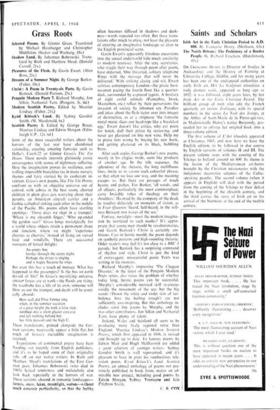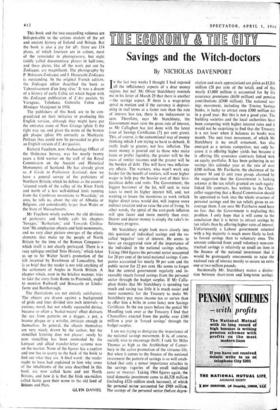Saints and Scholars
DR FRAKOISE HI \RV is Director of Studies in Archaeology and the History of Painting at University College, Dublin, and for many years has been one of the undisputed authorities on early Irish art. Her La Sculpture irlandaise, a truly pioneer work, appeared as long ago as 1932; it was followed, eight years later, by her Irish Art in the Early Christian Period. The brilliant group of men who edit the French quarterly art review Zodiaque, with its special numbers in the series La Mat des Temps, at the Abbey of Saint-Marie de la Pierre-qui-vire, in Mademoiselle Henry's native Burgundy, per- suaded her to enlarge her original book into a three-volume edition.
The first volume of L'Art irlandais appeared at Christmas 1943, and now here we have the English edition, to be followed in due course by English versions of volumes H and III. The present volume stops with the coming of the Vikings to Ireland around AD 800. Its theme is the fusion of the Mediterranean art-forms brought by the Christian missionaries with the indigenous decorative schemes of the Celtic- speaking peoples. The second volume (when it appears in English) will deal with the period from the coming of the Vikings to their defeat in the beginning of the eleventh century, and the third carries the story of Irish art to the arrival of the Normans at the end of the twelfth century. This book and the two succeeding volumes are indispensable to the serious student of the art and ancient history of Ireland and Britain. But the book is also a joy for all: there are 134 plates, of which fourteen are in colour, most of the remainder in photogravure, but eight (oddly called documentary plates) in half-tone, and these plates, like all the work put out by Zodiaque, are magnificent. The photography by P. Belzeaux-Zodiaque and J. Dieuzaide-Zodiaque is outstanding. In the original French edition, the Zodiaque editor described the book as `I'aboutissement d'un long rave.' It was a dream of a history of early Celtic art which began with the Zodiaque publication of L'Art gaulois, by Varagnac, Toledano, Gabrielle Fabre and Monique Mainjonet in 1956.
The publishers of this book are to be con- gratulated on their initiative in producing this English version, although they might have put the entrance stone of New Grange (plate 1) the right way up, and given the name of the bronze gilt plaque (plate 69) correctly as Markyate. Perhaps they could now be persuaded to give us an English version of L'Art gaulois.
Richard Feachem, now Archaeology Officer of the Ordnance Survey, was for nearly twenty years a field worker on the staff of the Royal Commission on the Ancient and Historical Monuments of Scotland. He has already given us A Guide to Prehistoric Scotland; now we have a general survey of the prehistory of Northern Britain, which he defines as the country 'situated south of the valley of the River Forth and north of a less well-defined limit running from the Cumbrian mountains to Weardale,' an area, he tells us, about the size of Albania or Belgium, and considerably larger than Wales or the State of Massachusetts.
Mr Feachem wisely eschews the old divisions of prehistory and boldly calls his chapters 'Savages,' Barbarians,' and 'Towards Civilisa- tion.'He emphasises objects and field monuments, and no very clear picture emerges of the ethnic elements that make up the people of North Britain by the time of the Roman Conquest— which itself is not clearly portrayed. There is a racy epilogue entitled 'Into History,' which takes us up to Sir Walter Scott's promotion of the kilt invented by Rawlinson of Lancashire, but is so brief that the reader is not told anything of the settlement of Angles in North Britain. A chapter which, even in the briefest manner, tries to take the story from Rome to Prestwick, ought to mention Ruthwell and Bewcastle or Lindis- farne and Bamborough. •
The illustrations are not entirely satisfactory. The objects are drawn against a background of grids and lines divided into inch intervals—a curious, novel, but not wholly successful device, because so often a 'basket-weave' effect distracts the eye from patterns on a dagger, a pot, a bronze plaque or a wristlet, intricate enough in themselves. In general, the objects themselves are very nicely drawn by the author, but the stencilled lettering does not please: surely by now stencilling has been outmoded by the Letraset and allied transfer-letter systems now on the market. None of the figures has a caption and one has to scurry to the back of the book to find out what they are. A final word : the reader ought to have had explained to him why some of the inhabitants of the area described in this book are now called Scots and not North Britons, and how it is that the Irish sea-raiders called Scotti gave their name to the old land of Britons and Picts.
GLYN DANIEL



































 Previous page
Previous page